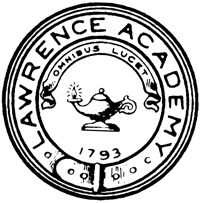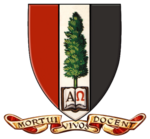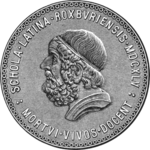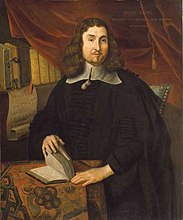
Phillips Academy is a co-educational college-preparatory school for boarding and day students located in Andover, Massachusetts, a suburb of Boston. The academy enrolls approximately 1,150 students in grades 9 through 12, including postgraduate students. It is part of the Eight Schools Association and the Ten Schools Admissions Organization.

Phillips Exeter Academy is a coeducational university preparatory private school for boarding and day students in grades 9 through 12, including postgraduate students. Located in Exeter, New Hampshire and founded in 1781, it is the sixth-oldest boarding school in the United States.

Roxbury is a neighborhood within the City of Boston, Massachusetts, United States.

John Eliot was a Puritan missionary to the American Indians who some called "the apostle to the Indians" and the founder of Roxbury Latin School in the Massachusetts Bay Colony in 1645. In 1660 he completed the enormous task of translating the Eliot Indian Bible into the Massachusett Indian language, producing more than two thousand completed copies.

Groton School is a private college-preparatory day and boarding school located in Groton, Massachusetts. It is affiliated with the Episcopalian tradition.

St. Paul's School is a college-preparatory, coeducational boarding school in Concord, New Hampshire, affiliated with the Episcopal Church. The school's 2,000-acre (8.1 km2), or 3.125 square mile, campus serves 540 students, who come from 37 states and 28 countries.
Tabor Academy is an independent preparatory school located in Marion, Massachusetts, United States. Tabor is known for its marine science courses. Tabor's location on Sippican Harbor, Buzzards Bay, has earned it the name of "The School by the Sea" and the school continues to operate a 115-foot sail training vessel, the SSV Tabor Boy as a hallmark program of the school. Tabor participates in the Independent School League (ISL) and is a member of the New England Preparatory School Athletic Council .

Lawrence Academy at Groton is a private, nonsectarian, co-educational college-preparatory boarding school located in Groton, Massachusetts. Founded in 1792 as Groton Academy and chartered in 1793 by Governor John Hancock, Lawrence is the tenth-oldest boarding school in the United States and the third-oldest in Massachusetts, following The Governor's Academy (1763) and Phillips Academy at Andover (1778).

Belmont Hill School is an independent boys school on a 32-acre (130,000 m2) campus in Belmont, a suburb of Boston. The school enrolls approximately 440 students in grades 7–12, separated into the Middle School and the Upper School, and refers to these grades as "Forms" with a Roman Numeral I through VI. While the majority of attending students are day students, there are some who enroll in the school's five-day boarding program, which becomes an option for students in their 9th grade year.
The Independent School League (ISL) is an athletic conference of sixteen private college-preparatory schools in Greater Boston. Its parent organization is the New England Preparatory School Athletic Council (NEPSAC). Founded in 1948, the ISL sponsors competitions in twenty-five sports.

St. Mark's School is an Episcopal college-preparatory day and boarding school in Southborough, Massachusetts, a suburb of Boston. Founded in 1865, it is one of the first British-style boarding schools in the United States.
Need-blind admission in the United States refers to a college admission policy that does not take into account an applicant's financial status when deciding whether to accept them. This approach typically results in a higher percentage of accepted students who require financial assistance and requires the institution to have a substantial endowment or other funding sources to support the policy. Institutions that participated in an antitrust exemption granted by Congress were required by law to be need-blind until September 30, 2022.

The Newman School is a private school in the Back Bay district of Boston, Massachusetts.

Concord Academy is a coeducational, independent college-preparatory school for boarding and day students in Concord, Massachusetts. CA educates approximately 400 students in grades 9-12. Unusually for a boarding school, a majority of CA students are day students.

Deerfield Academy is an independent college-preparatory boarding and day school in Deerfield, Massachusetts. Founded in 1797, it is one of the oldest secondary schools in the United States.

The Winsor School is a 5–12 private, college-preparatory day school for girls in Boston, Massachusetts, United States. It was established in 1886.

Boston Latin Academy (BLA) is a public exam school founded in 1878 in Boston, Massachusetts providing students in grades 7th through 12th a classical preparatory education.

The John D. O'Bryant School of Mathematics and Science, formerly known as Boston Technical High School is a college preparatory public exam school along with Boston Latin School and Boston Latin Academy. The O’Bryant specializes in science, technology, engineering and mathematics ("STEM") in the city of Boston, Massachusetts, and is named for one of Boston's prominent African-American educators John D. O'Bryant. The school is currently located on 55 Malcolm X Boulevard in the neighborhood of Roxbury, Massachusetts. With a student body of 1,500 7th–12th graders, this school is part of the Boston Public Schools. It currently shares a campus with the Madison Park Technical Vocational High School.
Ruth Marion Batson was an American civil rights activist and outspoken advocate of equal education. She spoke out about the desegregation of Boston Public Schools. She served as Chairman of the Public Education Sub-Committee of the National Association for the Advancement of Colored People (NAACP) in 1953. Later, she served as the executive director of the Metropolitan Council for Educational Opportunity (METCO).

Middlesex School is a coeducational, independent, and non-sectarian high school located in Concord, Middlesex County, Massachusetts. Founded in 1901 to educate the children of wealthy Boston Brahmin families, Middlesex introduced a national scholarship program in 1935 and currently educates 420 students from 32 U.S. states and 20 countries.





















